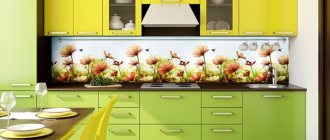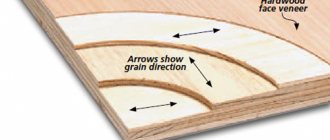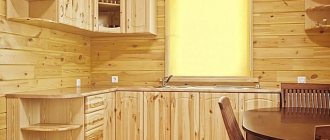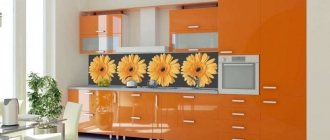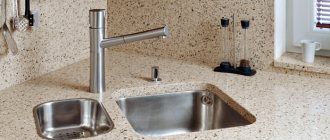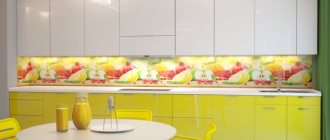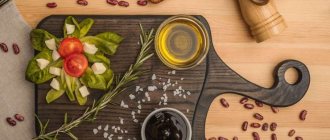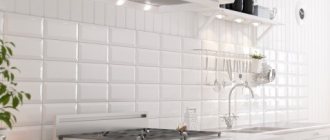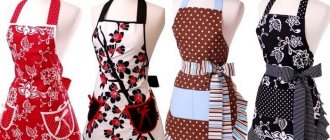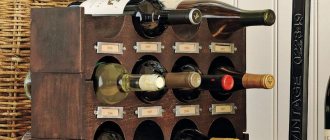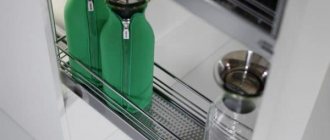When the question arises about choosing a material for decorating a kitchen apron, many potential buyers opt for plastic panels. The advantages of this material are obvious. Firstly, PVC (polyvinyl chloride) panels allow you to refresh the kitchen interior as quickly as possible and without large financial costs. Secondly, this material opens up great opportunities for designers.
A plastic kitchen apron is also good because it is very easy to install and unpretentious to use.
Features of a plastic apron
Depending on the type of coating, the service life of a plastic apron is usually no more than 3-5 years. You can find different types of products on sale, but to decorate the kitchen work area, it is best to choose monolithic polycarbonate sheets.
Of all types of plastic, polycarbonate is the most wear-resistant. In appearance it resembles glass, however, despite its visual fragility, it is the strongest of all polymers existing on the world market.
Design
The catalogs of modern manufacturers present both plain products and panels with fairly high-quality stylization of wood structure, brick or natural stone.
A huge variety of patterns and shades allows you to create truly beautiful and original interiors even with a very limited and modest budget. Although, in terms of decorative qualities, plastic products are slightly inferior to more expensive materials.
Benefits of use
In addition to the fact that plastic is one of the most budget-friendly materials, it also has some other undeniable advantages.
Among them we can especially highlight:
- light weight;
- hygiene;
- moisture resistance;
- wide range of decorative patterns and colors.
An undoubted advantage is also the ability to apply your own unique image to the surface of the selected material.
Flaws
In order not to be disappointed in the purchase, you must also carefully consider the main disadvantages of the plastic coating.
These include, first of all,:
- low resistance to scratches and mechanical damage;
- tendency to fade, especially with prolonged exposure to direct sunlight;
- low fire resistance;
- high sensitivity to aggressive detergents.
We must also not forget that panels made on the basis of polyvinyl chloride are an artificial material, so before purchasing you must pay attention to the availability of certificates. Products of dubious quality may contain components hazardous to health.
Types of material
From polyvinyl chloride you can create finishing materials of any shape and different appearance:
- in the form of a lining board;
- square;
- leafy;
- in one color;
- with thermal or offset printing;
- covered with laminate;
- varnished;
- having a frieze.
In some cases, it will be more convenient to take panels for operation. The common width of such products is 25 centimeters with a three-meter length, although there are other options. During installation, the seams between the panels are practically invisible. If you use sheets with a width of 80 to 200 centimeters and a length of 150 to 405, you can get a flat surface that gives the impression of a single sheet.
As for the decorative possibilities of PVC for the kitchen, they are unusually wide. You can choose slabs not only in one color, but also with patterns that make up entire pictures. Images are applied to PVC using photo printing; thermal film is used for this.
You can choose decor in country, Provence or any other style. Many images are aimed at whetting the appetite.
With one or another design of the apron, you can achieve a specific effect in the perception of the kitchen space, making it the highlight of the entire interior of the apartment.
Types of plastic aprons
Modern panels based on polyvinyl chloride are presented in a very rich assortment. They are classified both according to external indicators and operational characteristics.
PVC apron
As a rule, classic PVC panels belong to the lowest price segment. Typically, this material is sold in the form of small rectangular sheets or lining, and the thickness of the products can vary from 5 to 10 mm. Naturally, the greater the thickness of the plastic, the higher its resistance to various mechanical damage.
The front surface of this material can be very diverse. The number of color variations and shades has virtually no limits.
In general, a PVC apron cannot be called practical, since it is characterized by rapid abrasion of the pattern, especially with frequent use of detergents or with direct exposure to bright sunny colors.
ABS apron
In terms of cost, a kitchen apron made of ABS (impact-resistant technical thermoplastic resin) is on the same level as ceramic tiles. In terms of its technical and operational characteristics, this polymer is in many ways superior to PVC panels. In particular, it has increased resistance to various mechanical influences and better protection from negative environmental factors.
If we talk about the features of this type of plastic coating, then it is characterized by a slight yellowish tint, which, however, does not interfere with applying almost any highly realistic images and colors to its surface.
As a rule, an apron made of ABS plastic is also quite resistant to household chemicals, but when cleaning it is still recommended to use more gentle detergents.
Polycarbonate apron
Monolithic, or cast, polycarbonate is a structurally integral polymer material that, in appearance, resembles colored or transparent silicate glass. Despite the external resemblance to ordinary glass, this material is extremely impact-resistant. In this regard, carbonate is several dozen times superior to glass.
In addition to record impact resistance, a polycarbonate kitchen apron has other obvious advantages:
- light weight (any polycarbonate product is almost twice as light as glass);
- high resistance to many chemically active environments (the material is not affected by various food acids, fats, alcohols and aggressive household chemicals);
- good fire resistance (carbonate belongs to the group of self-extinguishing polymers, so even in the event of a strong fire it does not emit a lot of smoke);
- high light transmittance (transparent material transmits up to 88% of light).
The main disadvantage of a polycarbonate kitchen apron is its rather high cost compared to other types of plastic.
Solid sheet plastic
This type of plastic is produced in the form of large monolithic sheets. Thanks to its truly impressive size, a kitchen apron made from solid sheet plastic always turns out perfectly smooth and seamless.
As a rule, this is its main advantage, since in the absence of joints the risk of mold and various other fungal infections is significantly reduced.
In addition, a single, seamless surface usually looks more attractive, especially if a large, realistic image was chosen to decorate the kitchen work area.
Installation of single-sheet plastic is most often carried out using a special adhesive composition, which is applied in a single uniform layer to the entire surface of the plastic product.
Composite materials (MDF, chipboard)
Recently, various composite materials have become very popular. To decorate the kitchen work area, MDF (medium density fiberboard) or chipboard (chipboard) is most often used, but in exceptional cases some other varieties can be used.
Main advantages of MDF:
- high resistance to moisture;
- resistance to mechanical damage;
- a huge variety of drawings and images;
- the ability to imitate various natural surfaces and almost all types of finishes.
Other undoubted advantages also include easy maintenance and high resistance to mold and mildew.
Among the negative characteristics of MDF, one can note its low thermal stability and the need for mandatory protection of the ends of the panels with a high-quality aluminum or plastic profile.
Review of advantages and disadvantages
Why are plastic panels so popular? Yes, because plastic has its advantages:
- They are water tolerant. Plastic is not afraid of water, so it is easy to wash. And this is a huge plus for any housewife.
- Easy installation. To install a plastic panel, it is not necessary to have smooth walls (unless the materials require it). The installation is so easy that anyone can do it without much effort.
Design. You can apply a design to the plastic that your soul desires.
Low price. Plastic panels are often confused with glass. But the former are much cheaper than glass.
There are many advantages, but there are also disadvantages:
Not tolerant of fire. Since it is plastic, it melts when exposed to fire. And then he gives way to the same glass.
Fragility. If not properly cared for, the plastic panel loses its former appearance and is prone to damage. With the appearance of scratches, stains, and clouding of the surface, such a panel no longer looks aesthetically pleasing. Therefore, there is a possibility that it will need to be changed periodically.
Not environmentally friendly material. When plastic is exposed to fire, it begins to melt, releasing substances harmful to health. But now they are making better quality and environmentally friendly products. A special certificate allows you to find out how environmentally friendly a product is.
Rapid loss of color. Over time, the panel fades and loses its original shade and begins to turn yellow. But there are panels that contain UV-resistant pigments. But they are more expensive.
What to look for when choosing
A kitchen apron made of plastic has many advantages, but they are only relevant if high-quality products are initially selected.
The modern building materials market is full of fakes and low-quality goods, so when choosing high-quality plastic, you should definitely take into account the following nuances:
- Thickness. The larger this parameter, the stronger and more durable the material.
- View of the front surface. The color of the plastic product should be uniform without blurry spots or streaks.
- Availability of quality certificates. It is best to purchase products only from trusted manufacturers, since well-known companies usually value their reputation and are unlikely to produce products of poor quality. Uncertified facing materials may contain a large number of toxic and hazardous components to human health.
In the interior of any kitchen, an apron not only performs very important protective functions, but also plays a unique decorative role. Therefore, when choosing a plastic coating, it is necessary to take into account not only its operational and technical characteristics, but also its decorative and aesthetic properties.
As a rule, the facing material for the kitchen work area is selected to match the color of the countertop or kitchen unit, but if you wish and have good taste, you can experiment a little and choose a more non-standard solution.
Design options
Manufacturers offer a wide selection of designs for plastic panels. Here are the most common options:
Fruit theme
This design option is very popular. The combination of bright colors and gastronomic overtones of the design allows you to fit such an apron into almost any interior. It will look most advantageous in a kitchen with a neutral wall color and simple furniture.
Flower glade
Like the previous option, it goes harmoniously with a simple, minimalist or “rustic” style. Undesirable in a kitchen with heavy, carved furniture.
Natural tones
Imitating natural stone or wood can add a subtle combination of rigor and natural chaos. However, such elements are most often used in quite expensive kitchen sets. Perhaps the presence of a plastic apron in such an interior is not entirely appropriate.
Mirror surface
Ideal for decorating a small kitchen, as it will expand the space due to visual deception.
Often, on a kitchen apron there is an image of a night city, a bridge or other fundamental structure. This image would be appropriate in a high-tech kitchen, using metal elements and simple furniture.
DIY installation methods
Currently, there are several main methods of fixing plastic covering to the wall.
Depending on the characteristics of the kitchen work area, installation can be carried out in three different ways:
- The first method involves attaching plastic to a wooden or metal frame. As a rule, this type of installation is carried out only if the wall is uneven or has any other significant defects or flaws.
- If the wall does not have significant flaws, then the material is usually fixed using specialized adhesives. In this case, the glue is evenly applied to the entire surface of the material, after which the plastic is pressed tightly against the wall.
- The third installation option involves attaching the apron to self-tapping screws. As a rule, such an apron is very easy to dismantle, but after its installation it is necessary to mask the caps from the screws with plugs of a matching color.
When installing the apron on the frame, you need to take into account that in this case the plastic coating will be more vulnerable, since there is a significant gap between the wall and the facing material.
Definition of width
The width of the kitchen apron also matters, that is, the distance between its upper and lower edges (often this parameter is called the height of the apron).
What are the permissible maximum dimensions? If a washing machine is built under the countertop, then the height of the lower cabinets of the set together with the tabletop is no more than 90 cm. In this case, the distance from the table to the bottom of the wall cabinets should not exceed 110 cm, respectively, the maximum width of the apron should be within 112 cm (with taking into account 2 cm for overlap). This option is suitable for rooms with high ceilings and for fairly tall owners.
Installing panels using glue
After purchasing the type of plastic you like, you can begin installing it. If the installation will be carried out independently, you need to take into account that it is necessary to glue the apron in the kitchen made of plastic only with specialized adhesives without aggressive organic solvents.
The installation process itself is quite simple, but it requires the presence of an ideally leveled and dust-free working surface.
Typically, when installing a plastic apron, the following algorithm of actions is followed:
- First of all, surface preparation is carried out. The wall is thoroughly cleaned of the old coating and, if necessary, leveled.
- Before attaching the facing material to the wall, you should think about where the sockets, roof rails and possible lighting will be located. Any technological holes in the plastic are cut out before gluing it to the wall.
- It is necessary to glue the plastic apron to the wall only on a dry and grease-free surface. The adhesive composition is usually applied to the back of the material or to the entire working surface of the wall. In both cases, the glue consumption is approximately 300-350 g per 1 m2.
The adhesive composition usually sets almost instantly, but complete drying occurs after at least 24 hours.
Fixing the canvas
It should be understood that the wall panel is attached in a certain order. Experts recommend starting all work from the bottom and moving from the corner to the door or window. Before proceeding with such operations, all elements must be cut to the required size.
The algorithm for fastening such structures can be divided into several successive stages:
- Initially, the panel is placed in the correct position (level and in the right place). Then it is fixed to wooden slats using a screwdriver or stapler. All this depends on the design of a particular product.
- After this, the second element is inserted into a special groove of the previous working panel. In this case, you also need to control the horizontal or vertical level of this product. Fixation to the tree is carried out in the same way as in the previous stage.
- All other decorative elements are mounted in the same way. Upon completion, special skirting boards are installed at the ends to cover all defects and irregularities.
The wall panel can also be installed using a special adhesive solution. This method does not require the formation of a frame, but careful leveling of the base is necessary. Such options are used only for very small kitchens, where space plays an important role.
Care instructions
Everyone knows that careful care extends the life of any product, and a plastic kitchen apron is no exception.
To ensure that the coating lasts as long as possible, you must follow these recommendations:
- If possible, try to promptly remove drops of fat and any other persistent contaminants formed during the cooking process from the surface. Removing old grease stains can sometimes be problematic.
- To clean the surface, use only gentle detergents without aggressive chemical components and hard abrasive particles. If you use too aggressive household chemicals, the decorative pattern on the surface of the material may be damaged or scratched.
- When cleaning the apron, do not allow it to be over-wetted. Due to excess moisture, panels made of MDF or chipboard can swell and become deformed.
Also, during operation, you should remember that plastic is very susceptible to strong pinpoint impacts and the impact of any sharp objects. In addition, he is afraid of too high temperatures, so you need to try to treat the material carefully and not place any hot objects near its surface.
Wall requirements
It is better to remove wallpaper and other old finishes, smooth out uneven areas with strong putty, then dry.
In order to assess the evenness of the wall, if possible, apply finishing material to it and see if there are any bends or dips.
If they are not there, you can start gluing the apron. Otherwise, you will have to level the surface, or at least add leveling pads - plastic, cardboard, hardboard, etc. - to problem areas. - and only then glue the trim.
Installation of the apron is the final stage of finishing the kitchen, so by this time all construction, electrical and finishing work must be completed. Take care of installing electrical wiring, sockets, switches, and connecting household electrical appliances.
How to cover the dining area?
Laminated or veneered MDF boards are beautiful in structure and have a pleasant natural shade of wood, which is very suitable for creating a dining area, where a warm, homely atmosphere and comfort is created. In this case, such material will be much better than ceramic tiles and much more practical than wallpaper.
The dining area is usually located at some distance from the stove and the sink, and therefore there is no need to worry about excess moisture and temperature in this case. If desired, you can decorate the cooking and dining areas in different colors so that they are visually differentiated from each other. And if the size of the kitchen allows, then this division can be not only visual - between the two zones you can build a partition, for example, from MDF sheets in a wood look.
The partition itself, at your request, can be decorated with either expensive veneer, simple varnish or realistic photographs. Openwork partitions made of the same material, but laser-cut, are very impressive.
Fixing the canvas
It should be understood that the wall panel is attached in a certain order. Experts recommend starting all work from the bottom and moving from the corner to the door or window. Before proceeding with such operations, all elements must be cut to the required size.
The algorithm for fastening such structures can be divided into several successive stages:
- Initially, the panel is placed in the correct position (level and in the right place). Then it is fixed to wooden slats using a screwdriver or stapler. All this depends on the design of a particular product.
- After this, the second element is inserted into a special groove of the previous working panel. In this case, you also need to control the horizontal or vertical level of this product. Fixation to the tree is carried out in the same way as in the previous stage.
- All other decorative elements are mounted in the same way. Upon completion, special skirting boards are installed at the ends to cover all defects and irregularities.
The wall panel can also be installed using a special adhesive solution. This method does not require the formation of a frame, but careful leveling of the base is necessary. Such options are used only for very small kitchens, where space plays an important role.
Frame assembly
Before attaching wooden planks, experts recommend treating them with a special moisture-proof impregnation. This will significantly increase the service life of the frame and increase its resistance to the external environment.
The process of installing supports for sheet panels is correctly divided into several successive stages:
First of all, the wooden slats are cut according to the previously obtained dimensions. For such purposes, you can use a regular hacksaw. At this stage, the planks are attached to the wall, which should be located along the perimeter (horizontal). To fix them, use a hammer drill and self-tapping screws. When carrying out such operations, you should carefully monitor the level to form straight lines. After this, you need to place vertical jumpers between the previously fixed planks
Please note that you should not immediately attach them to the wall, but first need to align them in one plane using a stretched thread. When everything is ready, you can screw them to the wall using self-tapping screws.
If the frame is formed in hard-to-reach places, for example, between cabinets, it is advisable to take into account not only the visible space, but also the very size of the panel, which must be securely fixed in the future.
